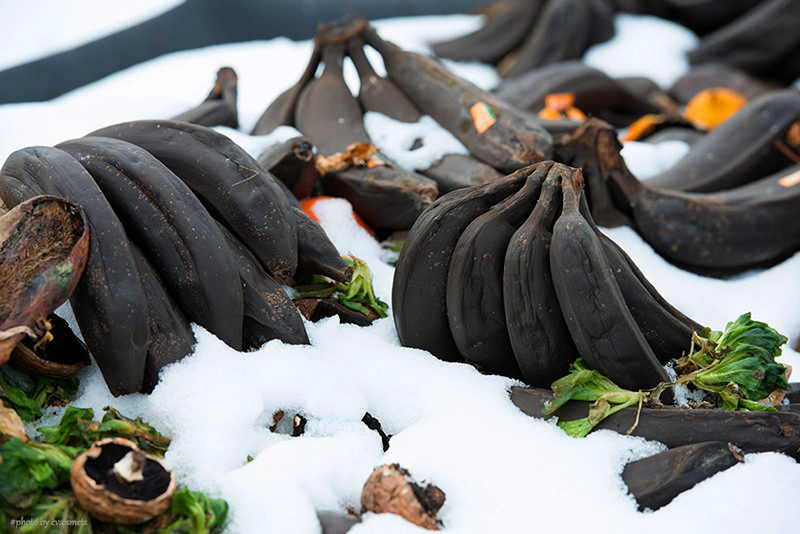
Come winter, the whole world slows down. The garden grows quiet, the buzz and hum of insect activity eventually disappears, and the larger animals (ourselves included!) retreat to ride out the season. The bacteria, fungi and other microorganisms that inhabit decomposing waste do the same. When a compost pile is allowed to go dormant during the winter months, the decomposition naturally slows or stops completely in the frigid temperatures. Left unattended, a dormant compost pile will patiently wait for warmer weather to continue its natural process.
While winter usually equates to a time of rest for the gardener, some are less than content to let the compost freeze over. Of course, the production of waste doesn’t end with the growing season—our kitchens still produce scraps that beg to find a home other than the landfill, and let’s not forget about all of those autumn leaves. Many gardeners appreciate having nutritionally dense compost to start the spring growing season with, too. So with a little preparation and a little effort throughout the winter, a biologically active compost pile can remain. Here’s what you’ll need to do to keep the outdoor bin going strong.
1. Keep Feeding

Even a winter-dormant compost pile is still an active mini-ecosystem, very much alive. As the mercury dips, the metabolism of the microbes inhabiting the compost pile slows down significantly. In order to keep a compost pile actively decomposing, those microbes need to be kept active and warm—and the best way to do this is to continue feeding them.
As with a summer compost pile, achieving a balance of “brown” and “green” material in the compost is the key to proper breakdown. Browns include carbon-rich ingredients: shredded leaves and newspaper, sawdust and straw, to name a few. Greens constitute nitrogen-rich items: most kitchen scraps, including fruit and vegetable scraps, coffee grounds, eggshells, leafy garden waste, and animal manure. A balance of about 30:1 carbon-to-nitrogen (give or take) works well to keep a compost in action.
When it comes to feeding your winter compost the right stuff, size matters. Break down or chop your compost ingredients to give the semi-dormant microbes a leg-up in their work during the decomposition process. Chop kitchen scraps into pieces about 2 inches long, and shred leaves and newspaper into small pieces.
Remember that the right amount of water is important in a healthy compost pile, too. In regions where it stays cold, dry and windy for long stretches, take advantage of any warm spells to water the pile until just damp, not soggy. The microorganisms need the moisture to survive.
2. Create Extra Heat
To combat the cold, it’s wise to employ the use of some naturally occurring heat sources. For starters, a compost heap is more successful when it’s exposed to the natural elements, including the heat of the sun. Winter compost piles are most successful if they’re placed in a location that receives as much direct sun as your region offers. Whether or not your compost gets the maximum amount of sun available to you during the winter, there are a few other methods of creating heat that you may want to try.
Creating windbreaks through the use of straw bales or hay bales situated around the pile will add an extra layer of insulation, giving the core of the compost a chance to really heat up. Snow is another great insulator, but with a double-edged sword: Long-standing layers may protect the compost’s core against deep freezes, but it also prevents thawing. Snow can be left on dormant or semi-dormant compost piles, but should be removed from heaps where scraps are still actively being added.
Some gardeners choose to take advantage of the naturally occurring temperature regulation of the earth to speed their winter composting. Where possible, earth can be dug up and piled around the compost to help retain heat. For those interested in longer-term and intensive winter composting, dig a trench in the earth to use as a winter compost bin.
Lastly, keep a layer of bedding on the top of your compost pile to maximize insulation. Straw, hay or even a layer of cardboard works great. Like the snow, be sure to remove the material before adding new ingredients, and then replace it once again.
3. Protect Against Scavengers

Whether you live on 100 undeveloped acres or in a suburb of a major city, some pests and scavengers, hungry in the winter due to lean meals and slim pickings, may come digging in your compost pile for an easy meal. Raccoons, opossums and neighborhood dogs are some of the most likely culprits. If you find evidence of animal intruders, such as big holes and evidence of digging, missing food scraps, and compost items strewn about the area, consider placing a screen barrier above your compost pile’s top insulation layer. A frame filled with chicken wire or an old screen door screwed into place or on hinges to make it easy to access the pile may do the trick.
4. Then Leave It Alone
In the warmer months, turning a compost pile introduces much-needed oxygen into the mix, assisting the decomposition process and giving the microbes the fresh air they need. But in the colder months, turning a compost pile breaks the layer of insulation created on the outside and can fatally expose the warm inner core of the pile. Once you’ve got a good rhythm of feeding, watering and insulating down, let the pile be and trust the little guys to do the rest.




